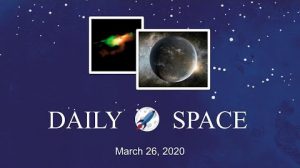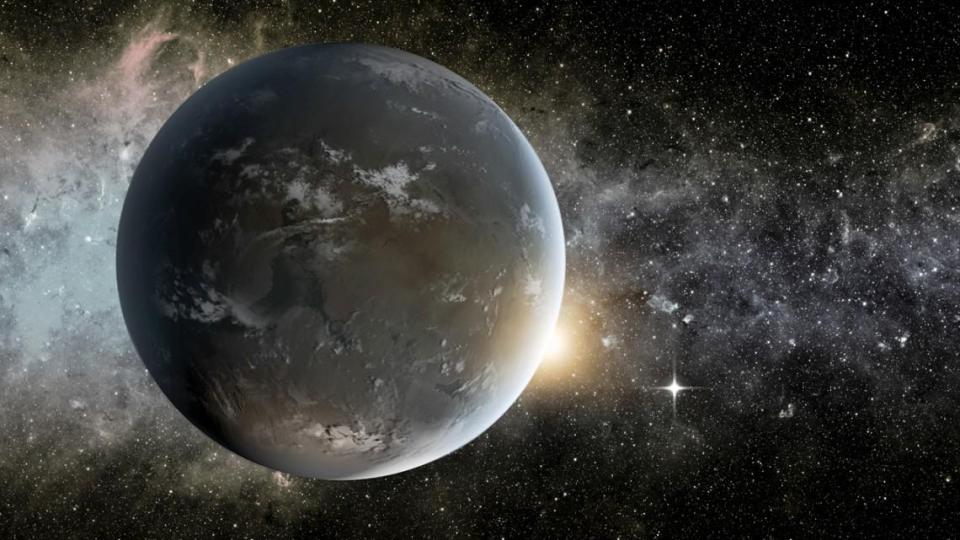
Researchers have defined how our world would look to distant observers during each of the periods in time, and ALMA shows us the MG J0414+0534, a galaxy 11 billion light years away, a galaxy with a disturbed shape, that is due radio jets turning on in a young galaxy.
Links
Using Evolution to hunt exoplanets
Alma sees gas jets influenced by black hole
Transcript
This is the Daily Space for today, Friday, March 27, 2020.
Welcome to the the Daily Space, I am your host, Dr Pamela Gay, and I am here to put science in your brain. Most Mondays through Fridays either I or my co-host Annie Wilson will be here, bringing you a quick run down of all that is new in space and astronomy.

This artistic depiction shows exoplanet Kepler-62f, a rocky super-Earth size planet, located about 1,200 light-years from Earth in the constellation Lyra. Kepler-62f may be what a prebiotic Earth may have looked like. Other exoplanets may look similar. CREDIT: NASA Ames/JPL-Caltech
In this modern world, we all find ourselves periodically wondering, “Is there a world out there I can escape to,” or “Can I shoot this other person off into space”. While you may not care if that space is all that habitable in the second case, finding a place capable of supporting life may matter more if it is yourself you’d like to take somewhere else.
The good folks at Cornell have your back. A team led by Lisa Kaltennegger has looked at the geologic and biologic history of our own mostly habitable planet and defined five key points in our world’s evolution. Using advanced computer models, they’ve defined how our world would look to distant observers during each of the periods in time. Specifically, they’ve defined our planet’s changing chemical barcode – that rainbow of light with superimposed dark lines that mark out the colors different elements absorb as sunlight passes through our Earth’s atmosphere. These kinds of spectral signatures won’t be unique to our Earth, this paper doesn’t just explain how our world might look to aliens: It also explains how alien worlds could look to us.
In their paper, this research team looks at how our earth would look currently as well as 3.9, 3.5, 1-2, and 0.5-0.8 Billion years ago. These specific periods correspond to our earth in its prebiotic days, when the atmosphere was dominated with CO2; to that Archean period when continents had just finished forming and life was just starting; to the Paleo- or Meso-proterozoic period when oxygen began to rise in our atmosphere thanks to life, and finally to the time when multi-cellular life began to dominant our world in the Neo-proterozoic period. While the model for today reflects the impacts of intelligence and the pollution that comes with industry, the early epochs show distinct changes that come from the presence of different kinds of life.
But taking into consideration the changes in planetary temperature, chemistry, and the biosignatures of life, they have provided observers with detailed charts of what we may someday see when we look at the atmosphere’s of distant worlds.
One of the great sadnesses of this paper is that the JWST will have the capacity to measure the atmospheres’ of planets outside our solar system. If it had launched in 2011 as planned, they could be going through its archive to say “This world matches the age of the dinosaurs, and this one may have its first single celled critters.” But… At this stage I have no idea when it will launch, and I don’t think anyone has any idea when it will launch, so for now… this is cool research with no application.

CREDIT: ALMA (ESO/NAOJ/NRAO), K. T. Inoue et al.
In our second story of the day, we have a pretty picture from ALMA that includes MG J0414+0534, a galaxy 11 billion light years away. This young galaxy has a disturbed shape, and astronomers have realized that what they’re seeing is radio jets turning on in a young galaxy.
We’ve previously seen myriad galaxies with active jets of material spewing out of their galactic disk. These jets are driven by the magnetic fields of accretion disks – those disks of material that spiral around actively feeding black holes. In addition to seeing active disks, we’ve also caught the light echoes of jets that have recently shut down, leaving disconnected light continuing its journey through space. What we hadn’t seen are young jets, just turning on.
According to team member Satoki Matsushita, of the Academia Sinica Institute of Astronomy and Astrophysics, “We are perhaps witnessing the very early phase of jet evolution in the galaxy. It could be as early as several tens of thousands of years after the launch of the jets.”
These new observations, published in the Astrophysical Journal Letters, were possible thanks to the magnifying powers of an intervening galaxy’s gravity. Gravity has the same ability to bend and seemingly magnify light that lenses have. Since space is mostly empty, it is rare that we find useful alignments of nearby massive galaxies and distant systems that are super scientifically interesting. In this case, we got lucky, and the gravitational lens in combination with the resolving power of ALMA was able to reveal details we would otherwise have never seen. We now have captured the birth and death of jets, and a myriad of examples of all the stages in between, and this will allow better future modeling of the life cycle feeding galaxies and their associated jets.
And that rounds out our show for today.
<———————>
As part of helping keep us all occupied in these really weird times, we’re going to be hosting a lot of additional content on our Twitch channel, and we want to remind you that CosmoQuest has an active community on Discord where you can talk science and even find other people to join you in playing some online games. You can find links to everything that is going on at CosmoQuest.org.
Thank you all for listening. Today’s script was written by Pamela Gay, and the Daily Space is produced by Susie Murph. The Daily Space is a product of the Planetary Science Institute, a 501(c)3 non profit dedicated to exploring our Solar System and beyond. We are here thanks to the generous contributions of people like you. The best way you can support us is through Patreon.com/cosmoquestx Like us? Please share us! You never know whose life you can change by adding a daily dose of science.


 We record most shows live, on Twitch. Follow us today to get alerts when we go live.
We record most shows live, on Twitch. Follow us today to get alerts when we go live.